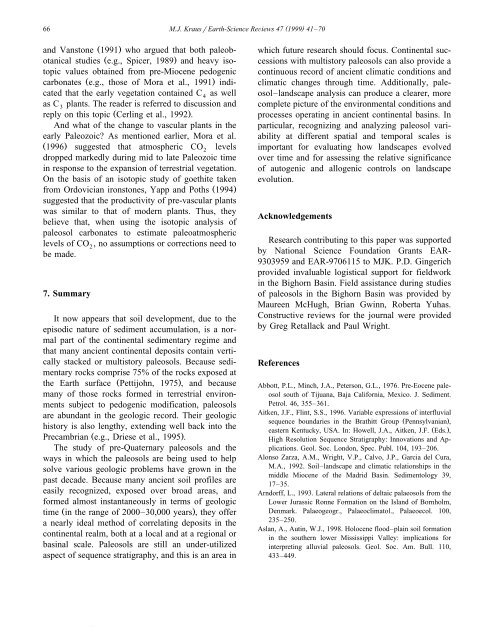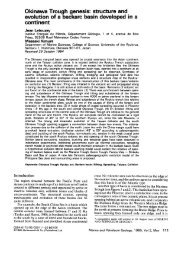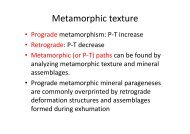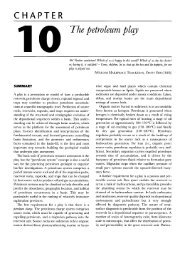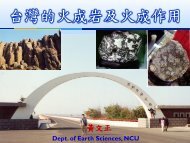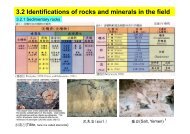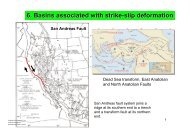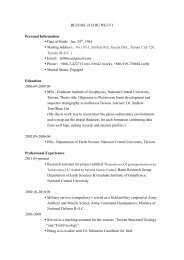66( )M.J. KrausrEarth-Science ReÕiews 47 1999 41–70and Vanstone Ž 1991.who argued that both paleobotanicalstudies Ž e.g., Spicer, 1989.and heavy isotopicvalues obta<strong>in</strong>ed from pre-Miocene pedogeniccarbonates Ž e.g., those of Mora et al., 1991.<strong>in</strong>dicatedthat the early vegetation conta<strong>in</strong>ed C 4 as wellas C 3 plants. The reader is referred to discussion andreply on this topic Ž Cerl<strong>in</strong>g et al., 1992 ..And what of the change to vascular plants <strong>in</strong> theearly Paleozoic? As mentioned earlier, Mora et al.Ž 1996.suggested that atmospheric CO2levelsdropped markedly dur<strong>in</strong>g mid to late Paleozoic time<strong>in</strong> response to the expansion of terrestrial vegetation.On the basis of an isotopic study of goethite takenfrom Ordovician ironstones, Yapp and Poths Ž 1994.suggested that the productivity of pre-vascular plantswas similar to that of modern plants. Thus, theybelieve that, when us<strong>in</strong>g the isotopic analysis ofpaleosol carbonates to estimate paleoatmosphericlevels of CO 2, no assumptions or corrections need tobe made.7. SummaryIt now appears that soil development, due to theepisodic nature of sediment accumulation, is a normalpart of the cont<strong>in</strong>ental <strong>sedimentary</strong> regime andthat many ancient cont<strong>in</strong>ental deposits conta<strong>in</strong> verticallystacked or multistory paleosols. Because <strong>sedimentary</strong><strong>rocks</strong> comprise 75% of the <strong>rocks</strong> exposed atthe Earth surface Ž Pettijohn, 1975 ., and becausemany of those <strong>rocks</strong> formed <strong>in</strong> terrestrial environmentssubject to pedogenic modification, paleosolsare abundant <strong>in</strong> the <strong>geologic</strong> record. Their <strong>geologic</strong>history is also lengthy, extend<strong>in</strong>g well back <strong>in</strong>to thePrecambrian Ž e.g., Driese et al., 1995 ..The study of pre-Quaternary paleosols and theways <strong>in</strong> which the paleosols are be<strong>in</strong>g used to helpsolve various <strong>geologic</strong> problems have grown <strong>in</strong> thepast decade. Because many ancient soil profiles areeasily recognized, exposed over broad areas, andformed almost <strong>in</strong>stantaneously <strong>in</strong> terms of <strong>geologic</strong>time Ž <strong>in</strong> the range of 2000–30,000 years ., they offera nearly ideal method of correlat<strong>in</strong>g deposits <strong>in</strong> thecont<strong>in</strong>ental realm, both at a local and at a regional orbas<strong>in</strong>al scale. <strong>Paleosols</strong> are still an under-utilizedaspect of sequence stratigraphy, and this is an area <strong>in</strong>which future research should focus. Cont<strong>in</strong>ental successionswith multistory paleosols can also provide acont<strong>in</strong>uous record of ancient climatic conditions andclimatic changes through time. Additionally, paleosol–landscapeanalysis can produce a clearer, morecomplete picture of the environmental conditions andprocesses operat<strong>in</strong>g <strong>in</strong> ancient cont<strong>in</strong>ental bas<strong>in</strong>s. Inparticular, recogniz<strong>in</strong>g and analyz<strong>in</strong>g paleosol variabilityat different spatial and temporal scales isimportant for evaluat<strong>in</strong>g how landscapes evolvedover time and for assess<strong>in</strong>g the relative significanceof autogenic and allogenic controls on landscapeevolution.AcknowledgementsResearch contribut<strong>in</strong>g to this paper was supportedby National Science Foundation Grants EAR-9303959 and EAR-9706115 to MJK. P.D. G<strong>in</strong>gerichprovided <strong>in</strong>valuable logistical support for fieldwork<strong>in</strong> the Bighorn Bas<strong>in</strong>. Field assistance dur<strong>in</strong>g studiesof paleosols <strong>in</strong> the Bighorn Bas<strong>in</strong> was provided byMaureen McHugh, Brian Gw<strong>in</strong>n, Roberta Yuhas.Constructive reviews for the journal were providedby Greg Retallack and Paul Wright.ReferencesAbbott, P.L., M<strong>in</strong>ch, J.A., Peterson, G.L., 1976. Pre-Eocene paleosolsouth of Tijuana, Baja California, Mexico. J. Sediment.Petrol. 46, 355–361.Aitken, J.F., Fl<strong>in</strong>t, S.S., 1996. Variable expressions of <strong>in</strong>terfluvialsequence boundaries <strong>in</strong> the Brathitt Group Ž Pennsylvanian .,eastern Kentucky, USA. In: Howell, J.A., Aitken, J.F. Ž Eds. .,High Resolution Sequence Stratigraphy: Innovations and Applications.Geol. Soc. London, Spec. Publ. 104, 193–206.Alonso Zarza, A.M., Wright, V.P., Calvo, J.P., Garcia del Cura,M.A., 1992. Soil–landscape and climatic relationships <strong>in</strong> themiddle Miocene of the Madrid Bas<strong>in</strong>. Sedimentology 39,17–35.Arndorff, L., 1993. Lateral relations of deltaic palaeosols from theLower Jurassic Ronne Formation on the Island of Bornholm,Denmark. Palaeogeogr., Palaeoclimatol., Palaeoecol. 100,235–250.Aslan, A., Aut<strong>in</strong>, W.J., 1998. Holocene flood–pla<strong>in</strong> soil formation<strong>in</strong> the southern lower Mississippi Valley: implications for<strong>in</strong>terpret<strong>in</strong>g alluvial paleosols. Geol. Soc. Am. Bull. 110,433–449.
( )M.J. KrausrEarth-Science ReÕiews 47 1999 41–70 67Atk<strong>in</strong>son, C.D., 1986. Tectonic control on alluvial sedimentationas revealed by an ancient catena <strong>in</strong> the Capella FormationŽ Eocene. of northern Spa<strong>in</strong>. In: Wright, V.P. Ž Ed. ., <strong>Paleosols</strong>:Their Recognition and Interpretation. Blackwell ScientificPublications, Oxford, pp. 139–179.Baldw<strong>in</strong>, B., Butler, C.O., 1985. Compaction curves. Am. Assoc.Pet. Geol. Bull. 69, 622–626.Besly, B.M., Field<strong>in</strong>g, C.R., 1989. Palaeosols <strong>in</strong> Westphaliancoal-bear<strong>in</strong>g and red-bed sequences, central and northern England.Palaeogeogr., Palaeoclimatol., Palaeoecol. 70, 303–330.Bestland, E.A., 1997. Alluvial terraces and paleosols as <strong>in</strong>dicatorsof early Oligocene climate change ŽJohn Day Formation,Oregon .. J. Sediment. Res. 67A, 840–855.Birkeland, P.W., 1984. Soils and Geomorphology, Oxford UniversityPress, New York, 372 pp.Blum, M.D., 1994. Genesis and architecture of <strong>in</strong>cised valley fillsequences: a Late Quaternary example from the ColoradoRiver, Gulf Coastal Pla<strong>in</strong> of Texas. In: Weimer, P. Posamentier,H. Ž Eds. ., Silici<strong>clastic</strong> Sequence Stratigraphy: RecentDevelopments and Applications, Am. Ass. Petrol. Geol. Mem.58, 259–283.Blum, M.D., Valastro, S. Jr., 1994. Late Quaternary sedimentation,lower Colorado River, Gulf Coastal Pla<strong>in</strong> of Texas. Geol.Soc. Am. Bull. 106, 1002–1016.Bockheim, J.G., 1980. Solution and use of chronofunctions <strong>in</strong>study<strong>in</strong>g soil development. Geoderma 24, 71–85.Bown, T.M., Kraus, M.J., 1981. Lower Eocene alluvial paleosolsŽ Willwood Formation, northwest Wyom<strong>in</strong>g, USA.and <strong>their</strong>significance for paleoecology paleoclimatology, and bas<strong>in</strong>analysis. Palaeogeogr., Palaeoclimatol., Palaeoecol. 34, 1–30.Bown, T.M., Kraus, M.J., 1987. Integration of channel and floodpla<strong>in</strong>suites: I. Developmental sequence and lateral relations ofalluvial paleosols. J. Sediment. Petrol. 57, 587–601.Bown, T.M., Kraus, M.J., 1993. Time-stratigraphic reconstructionand <strong>in</strong>tegration of paleopedologic, sedimentologic, and bioticevents ŽWillwood Formation, Lower Eocene, northwestWyom<strong>in</strong>g, USA .. Palaios 8, 68–80.Brady, N.C., 1990. The Nature and Properties of Soils. Macmillan,New York, 621 pp.Bridge, J.S., Leeder, M.R., 1979. A simulation model of alluvialstratigraphy. Sedimentology 26, 599–623.Caudill, M.R., Driese, S.G., Mora, C.I., 1996. Preservation of apaleo-Vertisol and an estimate of late Mississippian paleoprecipitation.J. Sediment. Res. 66A, 58–70.Caudill, M.R., Driese, S.G., Mora, C.I., 1997. Physical compactionof vertic palaeosols: implications for burial diagenesisand palaeo-precipitation estimates. Sedimentology 44, 673–685.Cerl<strong>in</strong>g, T.E., 1984. The stable isotopic composition of modernsoil carbonate and its relationship to climate. Earth Planet. Sci.Lett. 71, 229–240.Cerl<strong>in</strong>g, T.E., 1991. Carbon dioxide <strong>in</strong> the atmosphere: evidencefrom Cenozoic and Mesozoic paleosols. Am. J. Sci. 291,377–400.Cerl<strong>in</strong>g, T.E., 1992. Use of carbon isotopes <strong>in</strong> paleosols as an<strong>in</strong>dicator of the rŽ CO .2 of the paleoatmosphere. GlobalBiochem. Cycles 6, 307–314.Cerl<strong>in</strong>g, T.E., Quade, J., 1993. Stable carbon and oxygen isotopes<strong>in</strong> soil carbonates. Climate Change <strong>in</strong> Cont<strong>in</strong>ental IsotopicRecords. American Geophysical Union, pp. 217–231.Cerl<strong>in</strong>g, T.E., Wright, V.P., Vanstone, S.D., 1992. Further commentson us<strong>in</strong>g carbon isotopes <strong>in</strong> palaeosols to estimate theCO2content of the palaeo-atmosphere. J. Geol. Soc. London149, 673–676.Cerl<strong>in</strong>g, T.E., Wang, Y., Quade, J., 1993. Expansion of C4ecosystems as an <strong>in</strong>dicator of global ecological change <strong>in</strong> thelate Miocene. Nature 361, 344–345.Driese, S.G., Mora, C.I., 1993. Physico-chemical environment ofpedogenic carbonate formation <strong>in</strong> Devonian vertic palaeosols,central Appalachians, USA. Sedimentology 40, 199–216.Driese, S.G., Sr<strong>in</strong>ivasan, K., Mora, C.I., Stapor, F.W., 1994.Paleoweather<strong>in</strong>g of Mississippian Monteagle Limestone preced<strong>in</strong>gdevelopment of a lower Chesterian transgressive systemstract and sequence boundary, middle Tennessee andnorthern Alabama. Geol. Soc. Am. Bull. 106, 866–878.Driese, S.G., Simpson, E.L., Eriksson, K.A., 1995. Redoximorphicpaleosols <strong>in</strong> alluvial and lacustr<strong>in</strong>e deposits, 1.8 GaLochness Formation, Mount Isa, Australia; pedogenic processesand implications for paleoclimate. J. Sediment. Res.65A, 675–689.Duchaufour, P., 1982. Pedology. Allen and Unw<strong>in</strong>, London, 448pp.Fastovsky, D.E., McSweeney, K., 1987. <strong>Paleosols</strong> spann<strong>in</strong>g theCretaceous–Paleogene transition, eastern Montana and westernNorth Dakota. Geol. Soc. Am. Bull. 99, 66–77.Food and Agriculture OrganisationrUnited Nations Scientific andCultural Organization, 1974. Soil Map of the World. Vol. I,Legend. Unesco, Paris.Frakes, L.A., Sun, J., 1994. A carbon isotope record of the upperCh<strong>in</strong>ese loess sequence; estimates of plant types dur<strong>in</strong>g stadialsand <strong>in</strong>terstadials. Palaeogeogr., Palaeoclimatol., Palaeoecol.108, 183–189.Friedman, I., O’Neil, J.R., 1977. Compilation of stable isotopefractional factors of geochemical <strong>in</strong>terest. In: Fleischer, M.Ž Ed. ., Data of Geochemistry. U.S. Geol. Surv. Prof. Pap.440-KK, 12 pp.Ghosh, P., Bhattacharya, S.K., Jani, R.A., 1995. Palaeoclimateand palaeovegetation <strong>in</strong> Central India dur<strong>in</strong>g the Upper Cretaceousbased on stable isotope composition of the palaeosolcarbonates. Palaeogeogr., Palaeoclimatol., Palaeoecol. 114,285–296.Gill, S., Yemane, K., 1996. Implications of a Lower PennsylvanianUltisol for equatorial Pangean climates and early, oligotrophic,forest ecosystems. Geology 24, 905–908.Guccione, M.J., 1993. Gra<strong>in</strong>-size distribution of overbank sedimentand its use to locate channel positions. In: Marzo, M.,Puigdefabregas, C. Ž Eds. ., Alluvial Sedimentation. Int. Ass.Sediment., Spec. Publ. 17, 185–194.Hanneman, D.L., Wideman, C.J., 1991. Sequence stratigraphy ofCenozoic cont<strong>in</strong>ental <strong>rocks</strong>, southwestern Montana. Geol. Soc.Am. Bull. 103, 1335–1345.Hanneman, D.L., Wideman, C.J., Halvorson, J.W., 1994. Calcicpaleosols: <strong>their</strong> use <strong>in</strong> subsurface stratigraphy. Am. Assoc. Pet.Geol. Bull. 78, 1360–1371.


